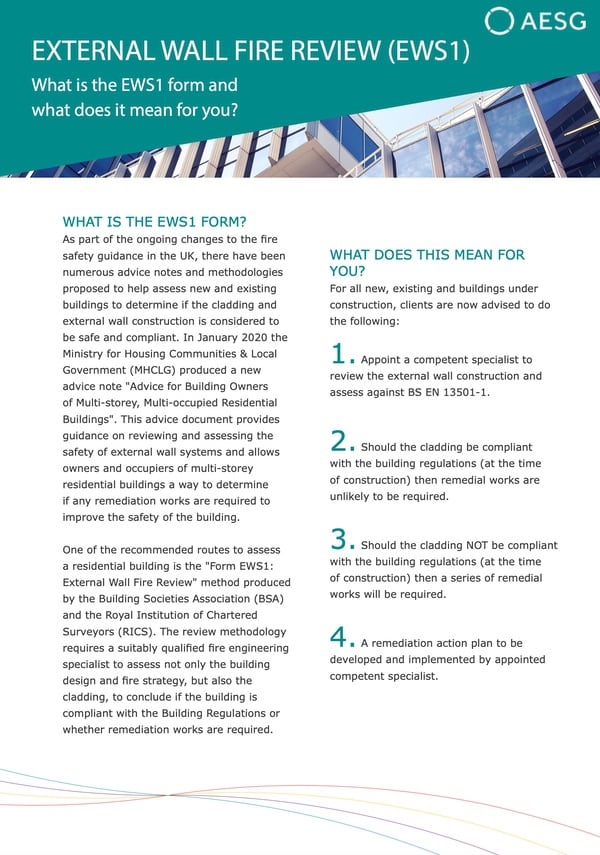
As part of the ongoing changes to the fire safety guidance in the UK, there have been numerous advice notes and methodologies proposed to help assess new and existing buildings to determine if the cladding and external wall construction is considered to be safe and compliant. In January 2020 the Ministry for Housing Communities & Local Government (MHCLG) produced a new advice note “Advice for Building Owners of Multi-storey, Multi-occupied Residential Buildings”. This advice document provides guidance on reviewing and assessing the safety of external wall systems and allows owners and occupiers of multi-storey residential buildings a way to determine if any remediation works are required to improve the safety of the building.
One of the recommended routes to assess a residential building is the “Form EWS1: External Wall Fire Review” method produced by the Building Societies Association (BSA) and the Royal Institution of Chartered Surveyors (RICS). The review methodology requires a suitably qualified fire engineering specialist to assess not only the building design and fire strategy, but also the cladding, to conclude if the building is compliant with the Building Regulations or whether remediation works are required.
For all new, existing and buildings under construction, clients are now advised to do the following:
AESG are fully qualified and competent to conduct these External Wall Fire Reviews with the collaboration between our Fire & Life Safety and Facade Engineering departments. We can offer the following scope of services to ensure that the EWS1 Form can be signed off at the end of the review.
| External Wall Fire Review Phase | Investigation | Outcome (s) |
|---|---|---|
| Phase 1: Desktop Study+ Site Visit | Review the building history, including: – Building Design & Changes to Design – Developer & Contractor/s – Materials – Installation – Evidence (Report, Photograph and Inspections documents) Site visit to undertake risk assessment of external wall construction and cavity barrier locations | Sign off Option A1 or A2 of EWSI Form. – No further action |
| Phase 2: Detailed Investigation & Reporting (If Option A3 or B1/2) | Inspection of materials. Risk assessment. Sampling and Laboratory Testing (if required) | Sign off EWS1 Form. – Recommend Remediation/Refurbishment. -No further action. |
| Phase 3: Remediation Action Plan | Preparation of Report specifying remediation and new cladding design requirements. | Remediation Action Plan and potentially new Cladding Design with drawings, specifications and bills of quantity |
| Phase 4: Remediation Works | Project Management of Remediation works. Supervision of replacement/ refurbishment works. Documentation – Golden Thread of Evidence. | Remediation works have been successfully completed and appropriately documented. |
| Phase 5: Validation Report | Preparation of Validation Report. | Building has been appropriately remediated. Sign off EWS1 Form. Golden Thread Report. |
For further information on the new EWS1 form, feel free to contact us